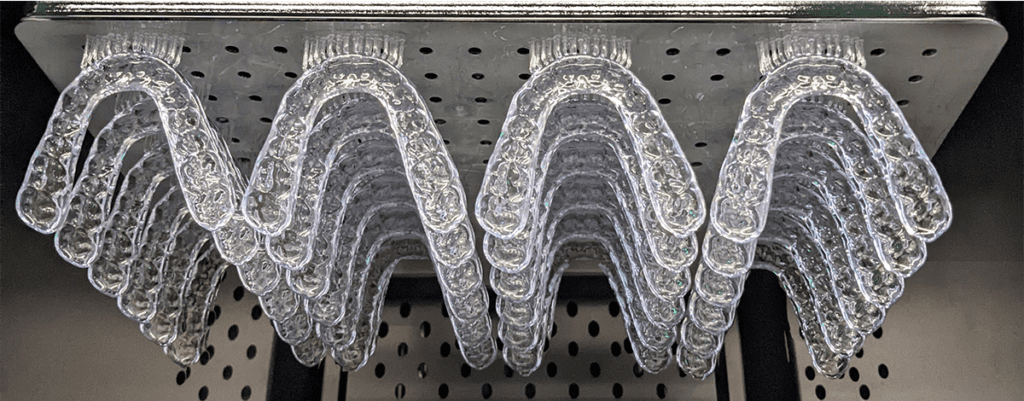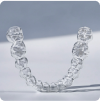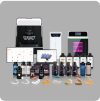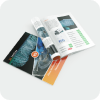
Choosing the Right 3D Printers for Dental Labs
Integrated Smart Factory 3D printing solutions replace traditional production processes in many industries. Dental laboratories have increasingly used additive manufacturing to optimize dental appliance production and, in some cases, transform the business model by enabling same-day delivery for dental appliances.
When selecting 3D printers for dental labs, evaluating how printers, software, and materials perform together is essential. Dental labs should consider production volume, ease of use, supported materials, and streamlined post-processing.
The ideal 3D printing solution for dental labs will lower the labor required to produce dental appliances, lower the total cost of production, streamline the fabrication process, and produce at a higher quality and scale than conventional methods.

Refining a Shortlist of Integrated Smart Factory 3D Printing Solutions
Before dental laboratories dive into printer specs like resolution and speed, they need to define the dental devices they plan to produce, their growth objectives, and other business goals and limitations. Examples of dental device production requirements include, but are not limited to, accuracy to produce high-quality products, maximum daily production, lowest labor cost/unit, low unit cost, lower the total cost of ownership, etc.
Integrated Smart Factory 3D printing solutions for dental appliances consist of finely-tuned printers, software, and materials to deliver the best blend of accuracy, throughput, automation, and lower cost. A lab must consider the following factors in each area to achieve the best combination of streamlined digitalized workflow, accuracy, production throughput, and economics that meets their business goals.
- Printer (Hardware): Printer specifications for many applications determine whether the printer can produce the specific dental appliance; however, these specifications do not define the batch quality, yield, or batch-to-batch consistency. When considering each printer candidate, printer specification is only one piece of the digital dentistry solution. Dental laboratories must assess the solution as a whole, not only for one batch print but for the full shift or multiple shifts. Successful customer references are the best way to ensure the solution will deliver each batch and shift. Within this context, 3D printer specifications ensure the minimum requirements are met, but dental laboratories should strive to adopt new additive capabilities, like Digital Polishing™ and the printer and solutions ability to support many dental devices. Today’s Smart Factory 3D printers supporting the next way of digital dentistry adoption deliver the best blend of high accuracy (50-100 micron resolution) and production efficiency. ROI and scalability assessments show that Smart Factory Dental 3D printers simplify dental lab production and automate workflow resulting in unmatched higher accuracy, daily production, and labor productivity.
- Software: Software maximizes Smart Factory dental 3D printing solution value and is tuned to the hardware and materials for each application. The software has a tremendous impact on how effective the Smart Factory dental 3D printing solutions deliver streamlined workflow and new game-changing capabilities like Digital Polishing™, which eliminates 90% of dental splint polishing steps. When evaluating 3D printing software, laboratories must have a production mindset: how easy is it to use and train new personnel, does it reduce design and production time, and can it give our laboratory a competitive advantage. The best 3D printing software for dental laboratories comes from the companies that design and manufacture complete solutions, including hardware, software, and materials. Quality software will enable more efficient production processes and well-managed workflows and can quickly be updated to improve efficiencies.
- Materials: Innovations in 3D printing resins achieve higher performance. However, some printers have limited material compatibility, restricting the breadth of applications they can address. Advanced materials have higher viscosity requiring more advanced printers with heating systems and higher light intensity or the right spectrum to use the newer materials for dental restorations, surgical guides, and orthodontic devices. The best 3D printing dental production solution will come from a company that developed its platform holistically. With this solution and production mindset, high-performance materials work best on printers, the software is ready to take full advantage of the printer and resins, and dental laboratories can maximize productivity and quickly train new technicians. Tight integration between hardware, software, and resins achieves higher overall productivity and enables dental laboratories to quickly and easily grow their business.
Four Considerations for the Best 3D Printers and Solutions for Dental Labs
After creating a shortlist of potential 3D printing solutions, the next step involves selecting the most viable system for a specific laboratory. The following three tips will help answer any lingering questions:
1. Calculate the Total Cost of Production
Investing in a 3D printing solution includes considering the total cost of production. Dental labs must weigh how processing and post-processing affect overall costs, volume output, and turnaround time. For example, a printer’s specs may claim to print a nightguard quickly. However, they neglect to mention how much post-processing is necessary. In many cases, the added time is substantial enough to cut profits and reduce overall output.
2. Examine Workflow
In a lab setting, maintaining a steady workflow is a top priority. Some 3D printer manufacturers do not create the software that runs their machines. The discrepancy between hardware and software can cause workflow interruptions related to equipment and file incompatibility.
Labs that choose 3D printing solutions with streamlined hardware, materials, and software eliminate such complications. LuxCreo’s dental printing solution, LuxaDent, streamlines production workflow by importing scanned models to batch nesting, and printer setting optimization provides each additive manufacturing element. Nesting, slicing, printing, washing, curing, and polishing all go through one machine.
3. Research Material Inputs
Dental labs create a wide variety of appliances, and 3D printing innovation can now accommodate many of them, including crowns, bridges, clear aligners, surgical guides, dentures, night guards, and more. The appliances made with 3D-printable materials prove faster, stronger, and more durable than those made with traditional methods and materials.
Find a 3D printer that uses the materials necessary to create a lab’s entire product line. Lesser material can shrink and distort during printing, rendering the device useless.
4. Consider Volume Output
3D printer models vary in speed, throughput, and build area. All of these elements impact the output capabilities of the machine. Some models may print quickly with high throughput, but their smaller build platforms limit how many models a lab can produce at one time. Machines with larger platforms can produce more models simultaneously, but they may create them at a lower resolution, sacrificing accuracy. Lower accuracy hinders specific devices such as restorative models or surgical guides.
Dental labs must consider these different factors and determine whether the machine will meet their needs to stay on a production schedule.
Complete Your 3D Printer Search
3D printing creates high-quality oral devices in a faster and less labor-intensive fashion than conventional approaches. However, 3D printers vary significantly in what devices they can make and how quickly they can produce them. While an industrial printer like the Lux 3+ can produce many devices, including dentures, clear aligners, and crowns, other printers may not have the accuracy required to make many of these appliances.

Additionally, the Lux 3+ can print up to 32 Keystone KeySplint Soft splints per batch in less than an hour using LEAP™ and with Digital Polishing™ laboratories, eliminating 90% post-process polishing. Other dental printers and dental 3D printing solutions that produce foggy, rough, and/or frosted cannot match this combined production throughput and directly print clear, transparent, and polished dental splints.
To take full advantage of Smart Factory 3D printing’s benefits for dental labs, find the best-suited solution for your operation. One must consider the sum of ownership, output potential, functionality, usability, and available materials. Companies that take all elements into account will make the most informed decision on which solution best meets their needs.
To learn more about LuxCreo’s 3D solutions and how to choose 3D printers for dental labs, visit our contact page or call (650) 336-0888.
Subscribe to Our Newsletter
Be the first to get our latest updates and free trials!
Popular Resources
Follow Us
Featured Products

4D Aligner™
First Smart ActiveMemory™
Aligner

iLux Pro Dental Solution
Ultimate 1-Click Dental
Application Solution

LuxCloud Dental
Your One-stop Digital Dentistry
Platform





